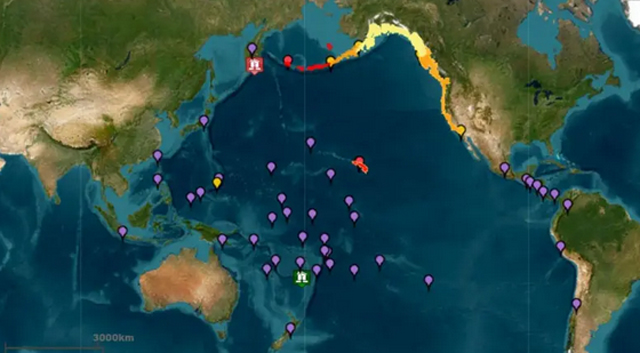News Flash

CHIBA, Japan, July 30, 2025 (BSS/AFP) - One of the strongest earthquakes ever recorded struck Russia's sparsely populated Far East early Wednesday, causing tsunamis up to four metres (12 feet) across the Pacific and sparking evacuations from Hawaii to Japan.
The magnitude 8.8 quake struck in the morning off Petropavlovsk on Russia's remote Kamchatka peninsula and was one of the 10 biggest recorded, according to the USGS.
Russian authorities said a tsunami hit and flooded the port town of Severo-Kurilsk, while local media said one of between three and four metres high was recorded in the Elizovsky district of Kamchatka.
A video posted on Russian social media showed buildings in the town submerged in seawater. Authorities said the population of around 2,000 people was evacuated.
Several people were injured in Russia by the quake, state media reported, but none seriously.
"The walls were shaking," a Kamchatka resident told state media Zvezda.
"It's good that we packed a suitcase, there was one with water and clothes near the door. We quickly grabbed it and ran out... It was very scary," she said.
- 'Not a regular wave' -
Authorities in Russia's far eastern Sakhalin region declared a state of emergency in the northern Kuril Islands. The mayor there said that "everyone" was evacuated to safety.
Officials from countries with a Pacific coastline in North and South America -- including the United States, Mexico and Ecuador -- issued warnings to avoid threatened beaches.
In Japan, nearly two million people were advised to evacuate, and many left by car or on foot to higher ground.
A 1.3-metre high tsunami reached a port in the northern prefecture of Iwate, Japan's weather agency said.
But there were no injuries or damage reported by early afternoon.
In Hawaii, Honolulu Mayor Rick Blangiardi said residents and the thousands of visitors should get to safety on upper floors of buildings or higher ground.
"People should not, and I will say it one more time, should not, as we have seen in the past, stay around the shoreline or risk their lives just to see what a tsunami looks like," governor Josh Green said.
"It is not a regular wave. It will actually kill you if you get hit by a tsunami," Green said.
- Pacific warnings -
Wednesday's quake was the strongest in the Kamchatka region since 1952, the regional seismic monitoring service said, warning of aftershocks of up to 7.5 magnitude.
The epicentre of the earthquake is roughly the same as the massive 9.0 temblor that year which resulted in a destructive, Pacific-wide tsunami, according to the USGS.
In December 2004, a 9.1 magnitude earthquake struck off the Indonesian island of Sumatra, triggering a tsunami that killed around 220,000 people in 11 nations.
On Wednesday at least six aftershocks further rattled the Russian Far East, including one of 6.9 magnitude and another listed at 6.3.
The US Tsunami Warning Centers said waves exceeding three metres above the tide level were possible along some coasts of Ecuador, northwestern Hawaiian islands and Russia.
Between one- and three-metre waves were possible along some coasts of Chile, Costa Rica, French Polynesia, Hawaii, Japan and other islands in the Pacific, it said.
Waves of up to one metre were possible elsewhere, including Australia, Colombia, Mexico, New Zealand, Tonga and Taiwan.
It described the potential conditions as "hazardous."
- Fukushima plant evacuated -
At Inage Beach in Chiba prefecture in Japan, a security perimeter was set up, and a rescue worker told AFP that the seaside area was off limits until further notice.
"I didn't expect there to be a tsunami; I actually made a joke about it when we heard (the alert)," Canadian tourist Leana Lussier, 17, told AFP.
"We came here hoping to swim, but once we heard a tsunami warning had been issued, we didn't go in at all, not even close to the water," local Tomoyo Fujita, 35, told AFP as she left the area with her young daughter.
Television footage showed several whales washed up on the shore, but officials told AFP that the animals beached on Tuesday before the tsunami.
Workers at the stricken Fukushima nuclear plant in northeast Japan -- destroyed by a huge quake and tsunami in 2011 -- were evacuated, its operator said.
Tsunami alerts were pushed to mobile phones in California, according to local AFP reporters.
"STAY STRONG AND STAY SAFE!" US President Donald Trump said on social media.
Tsunami sirens blared near Hawaii's popular Waikiki surf beach where an AFP photographer saw gridlocked traffic as Hawaiians escaped to higher ground.
- Hawaii-wide alert -
The US Tsunami Warning Centers issued a Tsunami Warning -- its highest level alert -- for the entire US state of Hawaii, with the first waves expected at 7:17 pm local time (0517 GMT).
"People are also advised to stay away from the beach and not to go to the coast," the seismology centre said in a warning.
Vessels were ordered to head to open water ahead of the expected arrival of waves up to two metres, while government employees in Honolulu were sent home early.
In Taitung in Taiwan, hotel resort worker Wilson Wang, 31, told AFP: "We've advised guests to stay safe and not go out, and to avoid going to the coast."
Pacific nation Palau, about 800 kilometres (500 miles) east of the Philippines, ordered the evacuation of "all areas along the coastline".